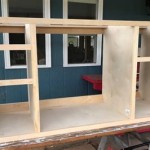How Much Does It Cost to Remove Old Kitchen Cabinets?
Removing old kitchen cabinets is a common step in kitchen renovation projects. Before installing new cabinets, the existing ones must be carefully taken down and disposed of. While seemingly straightforward, the cost associated with this task can vary significantly depending on several factors. Understanding these factors is crucial for budgeting and planning a kitchen remodel effectively.
The overall cost to remove old kitchen cabinets typically ranges from $50 to $500, but this can be a broad estimate. The final expense depends on whether the homeowner chooses to handle the removal as a DIY project or hire professional help. The complexity of the removal, the size of the kitchen, and disposal fees also affect the total cost. This article will delve into the various aspects that influence the price of removing old kitchen cabinets, allowing homeowners to make informed decisions about their kitchen renovation projects.
Key Point 1: DIY vs. Professional Removal Costs
One of the most significant factors affecting the cost of removing old kitchen cabinets is whether the homeowner chooses to undertake the task themselves or hire a professional. The DIY approach can save money on labor costs, but it requires time, effort, and a certain level of skill. Conversely, hiring professionals guarantees a faster and often more efficient removal process, but it comes at a higher price.
DIY Removal Costs: If opting for a DIY removal, the expenses are mainly associated with tools and disposal. Essential tools like screwdrivers, pry bars, utility knives, drills, and safety equipment (gloves, safety glasses, and masks) might need to be purchased if not already owned. These tools can cost anywhere from $20 to $100, depending on the quality and quantity. Disposal costs usually involve renting a dumpster or paying for disposal at a local landfill or recycling center. Dumpster rental prices range from $100 to $500 per week, depending on the size and location. Landfill disposal fees are typically calculated per ton of waste and can range from $50 to $100 per ton. Alternative disposal methods, such as donating usable cabinets to a charity or selling them online, can reduce or eliminate disposal costs. However, these methods require additional effort in preparing and transporting the cabinets.
Professional Removal Costs: Hiring professionals for cabinet removal involves paying for their labor, expertise, and equipment. The cost typically ranges from $70 to $200 per hour, but some contractors may offer a flat rate for the entire project. The total labor cost depends on the size of the kitchen and the complexity of the removal. Factors that can increase labor costs include difficult-to-reach cabinets, intricate cabinet designs, or the presence of hidden plumbing or electrical wiring. In addition to labor costs, professional removal services often include disposal fees in their quotes. This can be a convenient option for homeowners who do not want to deal with the hassle of arranging disposal themselves. Professional quotes should be carefully reviewed to understand whether disposal fees are included and what limitations apply.
Ultimately, the decision between DIY and professional removal depends on the homeowner's budget, skills, and time availability. For those with limited experience in home renovation, hiring professionals can be a worthwhile investment to ensure the job is done safely and efficiently.
Key Point 2: Factors Influencing Removal Complexity and Cost
The complexity of removing old kitchen cabinets significantly affects the associated costs. Several factors contribute to the difficulty and time required for removal, which in turn influence the price, whether it is a DIY project or a professional service.
Size and Layout of the Kitchen: Larger kitchens with more cabinets naturally require more time and effort to remove. A simple galley kitchen will be less time-consuming to dismantle than a large, custom-designed kitchen with multiple islands and intricate cabinetry. The layout also plays a role. Cabinets located in hard-to-reach areas, such as above refrigerators or in corners, may require specialized tools and techniques, increasing the complexity of the removal process.
Cabinet Construction and Installation: The way the cabinets were originally constructed and installed also affects the removal process. Cabinets that are securely fastened to the walls with multiple screws and adhesives are more difficult to remove than those with simpler installation methods. Custom-built cabinets, often found in older homes, may present unique challenges due to their unique construction and potentially outdated installation techniques. The presence of backsplashes or countertops attached to the cabinets can also complicate the removal process. If these elements need to be removed carefully to avoid damage to the surrounding walls or flooring, it will add to the time and cost.
Presence of Utilities: Kitchens often contain plumbing and electrical wiring behind or within the cabinets. Sinks, dishwashers, and garbage disposals require plumbing connections that must be disconnected before removing the cabinets. Electrical outlets and wiring for under-cabinet lighting must also be handled with care to avoid electrical hazards. If the homeowner is not comfortable working with plumbing or electrical systems, it is best to hire licensed professionals to disconnect and cap these utilities before removing the cabinets. This will add to the overall cost, but it is essential for safety and compliance with local building codes.
Condition of the Cabinets: The condition of the old cabinets can also affect the removal process. Cabinets that are severely damaged, rotted, or infested with pests may be more difficult and dangerous to remove. These cabinets may require special handling and disposal to prevent the spread of pests or contaminants. In some cases, professional removal services may charge extra for dealing with hazardous materials or unsanitary conditions.
Key Point 3: Disposal Options and Associated Costs
Proper disposal of the removed kitchen cabinets is an essential part of the overall project. The disposal method chosen can significantly impact the final cost, as well as the environmental impact. Several options are available, each with its own advantages and disadvantages.
Landfill Disposal: The most common method for disposing of old kitchen cabinets is to take them to a local landfill. Landfill disposal fees are typically charged per ton of waste. These fees can vary depending on the location and the type of waste. While this method is convenient, it is also the least environmentally friendly, as it contributes to landfill waste and can release harmful greenhouse gases. This can cost anywhere from $50 to $100 per ton, and potentially more if the landfill requires special handling of certain materials. Additionally, transportation costs to the landfill must be considered.
Dumpster Rental: Renting a dumpster is a convenient option for homeowners who have a large quantity of waste to dispose of. Dumpster rental companies offer various sizes of dumpsters to accommodate different project needs. The cost of renting a dumpster typically ranges from $100 to $500 per week, depending on the size and location. Dumpster rental includes delivery, pickup, and disposal fees. However, it is essential to check with the rental company about any restrictions on the types of materials that can be placed in the dumpster. Some companies may charge extra for disposing of certain items, such as appliances or hazardous waste.
Donation or Resale: Donating or reselling usable kitchen cabinets is a more environmentally friendly and potentially cost-effective alternative to landfill disposal. Many charities and non-profit organizations accept donations of used building materials, including kitchen cabinets. These organizations may offer free pickup services or provide a tax deduction for the donation. Selling the cabinets online or through local classifieds can also generate some income to offset the cost of the renovation project. However, this option requires more effort in preparing the cabinets for sale, such as cleaning, repairing, and photographing them. It may also take time to find a buyer.
Recycling: Some components of kitchen cabinets, such as wood, metal, and glass, can be recycled. Check with local recycling centers to see if they accept these materials. Recycling can reduce landfill waste and conserve natural resources. However, it may require separating the cabinets into their individual components and transporting them to different recycling facilities. The cost of recycling can vary depending on the type of material and the location of the recycling center. Some centers may offer free recycling, while others may charge a fee.
Deconstruction and Salvage: This method involves carefully dismantling the cabinets and salvaging usable components. This can be either a DIY project or done by a professional deconstruction company. Salvaged components, such as doors, drawers, hardware, and lumber, can be reused in other projects or sold to salvage yards. Deconstruction is a more time-consuming process than simply demolishing the cabinets, but it can significantly reduce waste and provide valuable materials for reuse.
Choosing the appropriate disposal method involves considering the cost, convenience, and environmental impact. Donating or reselling is generally the most sustainable option, but it requires more effort. Landfill disposal is the easiest but the least environmentally friendly. By carefully evaluating these factors, homeowners can make informed decisions about how to dispose of their old kitchen cabinets in a responsible and cost-effective manner.

How To Remove Kitchen Cabinets Budget Dumpster

How To Remove Kitchen Cabinets Budget Dumpster

How To Remove Kitchen Cabinets Budget Dumpster

Kitchen Removing Base Cabinet Countertops Backsplash

How To Remove Kitchen Cabinets Budget Dumpster

Average Cost To Replace Cabinets Forbes Home

How To Remove Your Cabinets Hometown Demolition

5 Reasons Why Pros Should Remove Your Old Cabinets

Average Cost To Reface Cabinets By Li Foot Material And Type Forbes Home

How To Remove Kitchen Cabinets A Diy Guide Dumpsters Com
Related Posts








